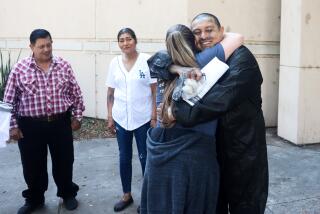Living With Tragedy of Near-Drowning
- Share via
To the many myths surrounding pool drownings, add two:
1. Children who are resuscitated after a near-drowning incident walk away unscathed.
2. Nothing could be as horrific as having a child drown.
Nadina Riggsbee knows the horror of losing a child to a drowning. She also knows what it’s like to have a child nearly drown. And in her case, the near-drowning is the more enduring nightmare.
On July 14, 1978, a baby-sitter left Riggsbee’s two toddlers unattended for 15 minutes and then found both children unconscious in the pool. Riggsbee’s 2-year-old daughter, Samira, never regained consciousness. One-year-old J.J. was eventually revived but suffered massive brain damage.
Last month, J.J. turned 20, but the celebration was bittersweet.
He is a severe quadriplegic who has lost most of his reflexes. He doesn’t speak, blink or move his eyes. He can’t sit up and suffers curvature of the spine. A tube inserted in his neck helps him breathe. Another tube in his stomach enables him to eat. He urinates through a catheter.
He lives at home and requires around-the-clock nursing care at a cost of $350,000 a year, most of which is covered by insurance.
“The death is an awful experience, but life does go on eventually,” said Riggsbee, a Danville, Calif., resident who established the Drowning Prevention Foundation after the tragedy. “With a child who is left with massive brain damage, you have a horrendous nightmare that never goes away.”
Riggsbee’s son is one of an estimated 300 brain-damaged near-drowners who are cared for in homes or community facilities in California. Another 75 are in state developmental centers, at an estimated average expense of $150,000 a year per person.
And that figure pales next to the emotional toll paid by family members forced to deal with the tragic reality of a child who will never be the same.
“It’s a terrible sight,” said Julie McComber, an occupational therapist at Fairview Developmental Center in Costa Mesa, a facility that is home for 16 near-drowners. “Most people think you either drown or you don’t. They don’t realize what can happen to the survivors.”
It takes roughly five minutes under water for the body’s oxygen reserves to be exhausted. Once that critical threshold is crossed, the brain, starved of oxygen and lacking an alternative energy source, begins to lose cells rapidly and irreversibly.
“With near-drowners, there don’t seem to be a lot of cases of just a little brain damage,” said Dr. Gary Goodman, director of the pediatric intensive care unit at Children’s Hospital in Mission Viejo. “We tend to see either complete recovery or very severe neurological injury.”
The first area of the brain to suffer damage in near-drowning incidents is the cerebral cortex, which is responsible for the brain’s highest conscious functions, including memory, speech and voluntary movement. Patients with this type of injury require at least basic custodial care, including help with eating, dressing and bathing. More severe cases require 100% care, including feeding and breathing tubes.
At Fairview, McComber and other occupational and physical therapists work with near-drowners on sensory stimulation and range of motion.
“Most of these patients are extremely spastic . . . arms and legs are flexed and very stiff,” she said. “As time goes on it gets worse and generally, after a few years, we can’t treat them anymore.”
Near-drowners suffer frequent complications that land them back in an acute-care facility, including orthopedic injuries, seizures and infections.
While pneumonia and other infections are a frequent cause of death among these patients, improved medical technologies have extended the near-drowner’s life expectancy.
“If the parents continue to want to have everything done for their child, that child can live for decades,” Goodman said. That, in most cases, only extends the agony.
“It is one of the most disruptive and destructive events that can happen to a family,” Goodman said.
“Very few families are able to remain intact. There’s always a sense of guilt and blaming. And when the child survives with a brain injury, there is a constant reminder of this terrible event.”
More to Read
Sign up for Essential California
The most important California stories and recommendations in your inbox every morning.
You may occasionally receive promotional content from the Los Angeles Times.










